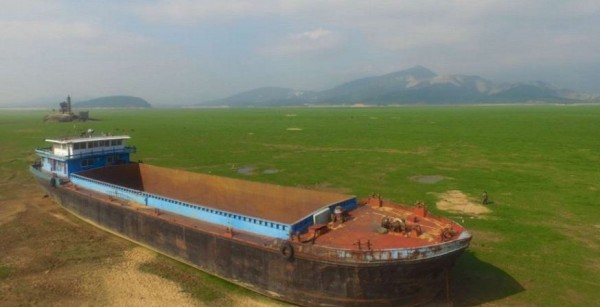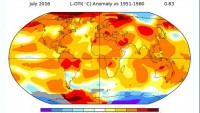Poyang Lake, China’s Largest Freshwater Lake, is Fast Drying-up and becoming a Prairie
| Arthur Dominic Villasanta | | Nov 05, 2016 09:38 AM EDT |
(Photo : Xinhua) Where's the water at Poyang Lake?
(Photo : Xinhua) The tall structure is a lighthouse. Note the cows grazing.
Poyang Lake in Jiangxi Province, once the largest freshwater lake in China, is fast drying-up and might soon become a prairie or a desert like the Aral Sea in Kazakhstan due mostly to human ignorance.
Chinese scientists are reporting with alarm that more parts of Poyang Lake have dried up leaving huge swathes of grassland in areas once inundated by up to 25 meters of water. That depth has been reduced on average to only eight meters and even this level is in danger since water levels have fallen continuously since September.
Like Us on Facebook
The lake's water level in eastern Jiangxi as measured by the Xingzi hydrological station plunged dropped to 10.6 meters on Nov. 3. The lake entered its low-water period of less than 12 meters on September 19, 54 days earlier than usual.
The early low-water period can partly be blamed on decreasing water levels in the Yangtze River, reduced rainfall and human activities, said Zhu Lilai, deputy director of the water resources department of Jiangxi.
The lake is fed by the Gan, Xin and Xiu rivers that connect to the Yangtze through a channel. Historically, the lake is known for its abundance in freshwater fish and shrimps and supplied water for nearby rice fields.
The area of Poyang Lake fluctuates dramatically between the wet and dry seasons. In recent years, however, the size of the lake has been decreasing overall. In a normal year the area of the lake averages 3,500 square kilometers. In early 2012, the size of the lake reached a low of 200 square kilometers.
Scientists report tourists can now walk on the former lakebed in Duchang county as if they were wandering through fields. The lakebed is covered by flowering aubergine plants. Cattle are grazing on the exposed bed at Lushan.
Poyang Lake might soon share the fate of the Aral Sea, once the world's fourth largest lake, whose shrinking has been described as "one of the planet's worst environmental disasters."
Once with an area of 68,000 km2, the Aral Sea has been steadily shrinking since the 1960s.
By 2007, it had declined to 10% of its original size, splitting into four lakes. By 2009, the southeastern lake had disappeared and the southwestern lake had retreated to a thin strip at the western edge of the former southern sea.
Satellite images taken by NASA in August 2014 revealed that for the first time in modern history, the eastern basin of the Aral Sea had completely dried up. The eastern basin is now called the Aralkum Desert.
TagsPoyang Lake, drying-up, Aral Sea, Jiangxi Province, china
©2015 Chinatopix All rights reserved. Do not reproduce without permission
EDITOR'S PICKS
-

Did the Trump administration just announce plans for a trade war with ‘hostile’ China and Russia?
-

US Senate passes Taiwan travel bill slammed by China
-

As Yan Sihong’s family grieves, here are other Chinese students who went missing abroad. Some have never been found
-

Beijing blasts Western critics who ‘smear China’ with the term sharp power
-

China Envoy Seeks to Defuse Tensions With U.S. as a Trade War Brews
-

Singapore's Deputy PM Provides Bitcoin Vote of Confidence Amid China's Blanket Bans
-

China warns investors over risks in overseas virtual currency trading
-

Chinese government most trustworthy: survey
-

Kashima Antlers On Course For Back-To-Back Titles
MOST POPULAR
LATEST NEWS
Zhou Yongkang: China's Former Security Chief Sentenced to Life in Prison

China's former Chief of the Ministry of Public Security, Zhou Yongkang, has been given a life sentence after he was found guilty of abusing his office, bribery and deliberately ... Full Article
TRENDING STORY

China Pork Prices Expected to Stabilize As The Supplies Recover

Elephone P9000 Smartphone is now on Sale on Amazon India

There's a Big Chance Cliffhangers Won't Still Be Resolved When Grey's Anatomy Season 13 Returns

Supreme Court Ruled on Samsung vs Apple Dispute for Patent Infringement

Microsoft Surface Pro 5 Rumors and Release Date: What is the Latest?















